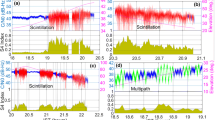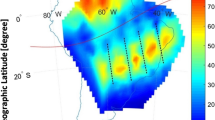Abstract
Loss of lock (LoL) may occur due to receiver dynamics, multipath, and interference apart from the ionospheric irregularities for a given receiver configuration. This study makes a robust analysis of the LoL using multi-frequency GNSS observations during 2014–2017 from a low latitude station at Waltair, India. With possibly the first such results from India, this study shows a strong seasonal, local time, and solar activity dependence of the LoL. While the LoL occurrence is found to increase with the severity of scintillation and maximize for strong scintillations, it is also found that the LoL may occur at any level of S4 due to other dominating factors. It is found that while the weak and moderate S4 events weigh the distribution, they correspond to fewer than 15% of the total LoL. A combination of 0.5 < S4 < 0.7 and 0.4 < \(\sigma_{\varphi }\) < 0.6 is found to produce LoL for most of the seasons for all the signals. A limitation of the scintillation data is highlighted wherein spurious values of 60-s \(\sigma_{\varphi }\) (i.e. \(\sigma_{\varphi }\) > 1.5) are found to constitute more than 53% of total LoL events against the widely accepted \(\sigma_{\varphi }\) < 1.5. The LoL events are found to increase over latitudes away from the dip equator for most of the signals, whereas they decrease with an increasing elevation angle of IPP, possibly due to multiple refractions over excess path lengths at lower elevation angles and a latitudinal gradient in the electron density. A combination is found composed of S4 > 0.6 and \(\sigma_{\varphi }\) > 1.5 with lower elevation angles that produce more LoL events between 20:00 and 22:00 local times. New probabilistic forecast models for the occurrence of the LoL are finally given for the different seasons against S4, \(\sigma_{\varphi }\) and local time that would be useful for different applications.













Similar content being viewed by others
Data availability
Data used in the present study are available with the Department of Physics, Andhra University, Visakhapatnam. The post-analysis data sets used in the plots can be obtained from the corresponding author (ND).
References
Banola S, Pathan BM, Rao DRK, Chandra H (2005) Spectral characteristics of scintillations producing ionospheric irregularities in the Indian region. Earth Planets Space 57(1):47–59. https://doi.org/10.1186/BF03351805
Basu S et al (1996) Scintillations, plasma drifts, and neutral winds in the equatorial ionosphere after sunset. J Geophys Res 101(A12):26795–26809. https://doi.org/10.1029/96JA00760
Beach TL (2006) Perils of the GPS phase scintillation index (σφ). Radio Sci 41(5):RS5S31. https://doi.org/10.1029/2005RS003356
Carrano CS, Groves KM (2010) Temporal decorrelation of GPS satellite signals due to multiple scattering from ionospheric irregularities. In: Proceedings of ION GNSS 2010. Institute of Navigation, Portland, pp 361–374
Chen W, Gao S, Hu CW, Chen YQ, Ding XL (2008) Effects of ionospheric disturbances on GPS observation in low latitude area. GPS Solut 12(1):33–41. https://doi.org/10.1007/s10291-007-0062-z
Conker RS, El-Arini MB, Hegarty CJ, Hsiao T (2003) Modeling the effects of ionospheric scintillation on GPS/satellite-based augmentation system availability. Radio Sci 38(1):1001. https://doi.org/10.1029/2000RS002604
Damaceno J, Bruno J, Bolmgren K, De Franceschi G, Mitchell C, Cafaro M (2020) GPS loss of lock statistics over Brazil during the 24th solar cycle. Adv Space Res 66(2):219–225. https://doi.org/10.1016/j.asr.2020.03.041
Das Gupta A, Ray S, Paul A, Banerjee P, Bose A (2004) Errors in position-fixing by GPS in an environment of strong equatorial scintillations in the Indian zone. Radio Sci 39(1):RS1S30. https://doi.org/10.1029/2002RS002822
Dashora N, Pandey R (2005) Observations in equatorial anomaly region of total electron content enhancements and depletions. Ann Geophys 23(7):2449–2456. https://doi.org/10.5194/angeo-23-2449-2005
Dashora N, Suresh S (2015) Characteristics of low-latitude TEC during solar cycles 23 and 24 using global ionospheric maps (GIMs) over Indian sector. J Geophys Res Space Phys 120(6):5176–5193. https://doi.org/10.1002/2014JA020559
Doherty PH, Delay SH, Valladares CE, Klobuchar JA (2003) Ionospheric scintillation effects on GPS in the equatorial and auroral regions. J Inst Navig 50(4):235–246. https://doi.org/10.1029/2007RS003715
Forte B (2008) Refractive scattering evidence from multi frequency scintillation spectra observed at auroral latitudes. Radio Sci 43(2):RS2012. https://doi.org/10.1029/2007RS003715
Forte B, Radicella SM (2002) Problems in data treatment for ionospheric scintillation measurements. Radio Sci 37(6):1096. https://doi.org/10.1029/2001RS002508
Goswami S, Ray S, Paul A (2020) Degradation of satellite-based navigation performance observed from an anomaly crest location in the Indian longitude sector. Radio Sci 55(8):e2019RS007042. https://doi.org/10.1029/2019RS007042
Guo K, Aquino M, Vadakke Veettil S (2019) Ionospheric scintillation intensity fading characteristics and GPS receiver tracking performance at low latitudes. GPS Solut 23:43. https://doi.org/10.1007/s10291-019-0835-1
Kintner PM, Ledvina BM, de Paula ER, Kantor IJ (2004) Size, shape, orientation, speed, and duration of GPS equatorial anomaly scintillations. Radio Sci 39(2):RS2012. https://doi.org/10.1029/2003RS002878
Kintner PM, Ledvina BM, de Paula ER (2007) GPS and ionospheric scintillations. Space Weather 5(9):1–23. https://doi.org/10.1029/2006SW000260
Leick A, Rapoport L, Tatarnikov D (2015) GPS satellite surveying, 4th edn. Wiley, New York
Liu Y, Fu L, Wang J, Zhang C (2017) Study of GNSS loss of lock characteristics under ionosphere scintillation with GNSS data at Weipa (Australia) during solar maximum phase. Sensors 17(10):2205. https://doi.org/10.3390/s17102205
Moraes AO, Costa E, Abdu MA, Rodrigues FS, de Paula ER, Oliveira K, Perrella WJ (2017) The variability of low-latitude ionospheric amplitude and phase scintillation detected by a triple-frequency GPS receiver. Radio Sci 52(4):439–460. https://doi.org/10.1002/2016RS006165
Moraes AO, Vani BC, Costa E, Abdu MA, de Paula ER, Sousasantos J, Monico JFG, Forte B, de Siqueira Negreti PM, Shimabukuro MH (2018) GPS availability and positioning issues when the signal paths are aligned with ionospheric plasma bubbles. GPS Solut 22:95. https://doi.org/10.1007/s10291-018-0760-8
Morrissey TN, Shallberg KW, Van Dierendonck AJ, Nicholson MJ (2004) GPS receiver performance characterization under realistic ionospheric phase scintillation environments. Radio Sci 39(1):RS1S20. https://doi.org/10.1029/2002RS002838
Nocedal J, Wright S (2006) Numerical optimizations. Springer, New York
Olwendo JO, Cilliers P, Weimin Z, Ming O, Yu X (2018) Validation of ROTI for ionospheric amplitude scintillation measurements in a low-latitude region over Africa. Radio Sci 53(7):876–887. https://doi.org/10.1029/2017RS006391
Sethi HS, Dashora N (2020) Automated power spectrum analysis of low-latitude ionospheric scintillations recorded using software GNSS receiver. GPS Solut 24(1):33. https://doi.org/10.1007/s10291-019-0945-9
Shanmugam S, Jones J, MacAulay A, Van Dierendonck AJ (2012) Evolution to modernized GNSS ionospheric scintillation and TEC monitoring. In: Proceedings of IEEE/ION PLANS 2012, Myrtle Beach, South Carolina, USA. https://doi.org/10.1109/PLANS.2012.6236891
Skone S, Knudsen K, de Jong M (2001) Limitations in GPS receiver tracking performance under ionospheric scintillation conditions. Phys Chem Earth A 26(6–8):613–621. https://doi.org/10.1016/S1464-1895(01)00110-7
Sreeja VV et al (2011) Tackling ionospheric scintillation threat to GNSS in Latin America. J Sp Weather Sp Clim 1(1):A05. https://doi.org/10.1051/swsc/2011005
Srinivasu VKD, Dashora N, Prasad DSVVD, Niranjan K, Gopi Krishna S (2018) On the occurrence and strength of multi-frequency multi-GNSS ionospheric scintillation in Indian sector during declining phase of solar cycle 24. Adv Space Res 61(7):1761–1775. https://doi.org/10.1016/j.asr.2017.08.036
Steigenberger P, Thoelert S, Montenbruck O (2018) GNSS satellite transmit power and its impact on orbit determination. J Geod 92(6):609–624. https://doi.org/10.1007/s00190-017-1082-2
Strangeways HJ (2009) Determining scintillation effects on GPS receivers. Radio Sci 44(1):RS0A36. https://doi.org/10.1029/2008RS004076
Vadakke Veettil S, Aquino M (2021) Statistical models to provide meaningful information to GNSS users in the presence of ionospheric scintillation. GPS Solut 25:54. https://doi.org/10.1007/s10291-020-01083-x
Acknowledgements
One of the authors (V. K. D. S.) acknowledges the post-doctoral fellowship provided by NARL, and one of the authors (K. N.) acknowledges the Emeritus Scientist Program of Council of Scientific and Industrial Research (CSIR), New Delhi, India. Authors thankfully acknowledge DRAO, Penticton, Canada, for providing F10.7 cm solar flux data available at http://www.spaceweather.gc.ca/solarflux/sx-5-eng.php.
Author information
Authors and Affiliations
Corresponding author
Additional information
Publisher's Note
Springer Nature remains neutral with regard to jurisdictional claims in published maps and institutional affiliations.
Supplementary Information
Below is the link to the electronic supplementary material.
Rights and permissions
About this article
Cite this article
Srinivasu, V.K.D., Dashora, N., Prasad, D.S.V.V.D. et al. Loss of lock on GNSS signals and its association with ionospheric irregularities observed over Indian low latitudes. GPS Solut 26, 34 (2022). https://doi.org/10.1007/s10291-021-01218-8
Received:
Accepted:
Published:
DOI: https://doi.org/10.1007/s10291-021-01218-8




